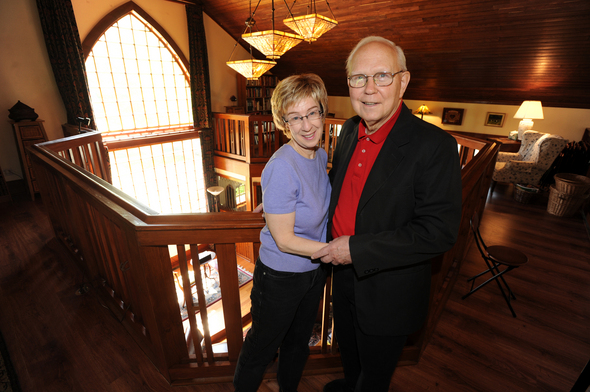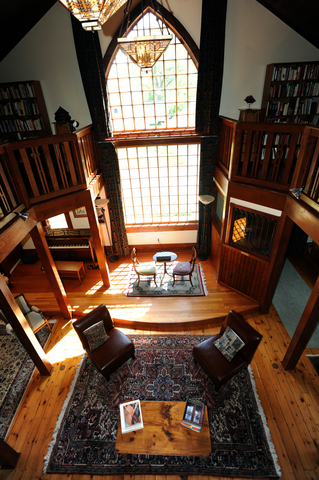Ann Arbor City Club tour features church that was remodeled into home

Carl Rinne and Tamara Real in the upstairs of their home, a former church at 411 Fountain St., Ann Arbor.
Lon Horwedel | AnnArbor.com
They converted the historic but timeworn Fountain Street church with rotting orange carpet and a dilapidated Michigan basement into an architectural gem defined by a towering Gothic window at its front. The church had passed through the hands of three congregations before Real and Rinnes bought it.
“It spoke to us,” Carl said.

The interior of Carl Rinne and Tamara Real's home, a former church at 411 Fountain St.
Lon Horwedel | AnnArbor.com
After Real and Rinne married, they began looking for a new home. The only requirement, Real said, was that it had to be architecturally interesting.
The Fountain Street church, with a for sale sign on the front lawn, fit the bill.
The structure was built in 1907 as the First Baptist Church on Miller Avenue near the entrance of what is today West Park. In 1926, it was sold to the Pilgrim Holiness church, with the proviso that it be moved. It landed on Fountain Street.
In 1962, the church was sold to the Church of God in Christ.
When the couple bought the church in 2000, they decided to move the structure once more, but this time 40 feet to the north. They needed to dig a new basement anyway, and the move would give it more space between the house next door, Real said.
The house had to be gutted, but pieces were salvaged and treasures uncovered: They peeled off the old carpet and layers of stubborn glue and refinished the original knotty pine floors, leaving a small square painted brown as a reminder of the past and the minister who painted it. They used original wainscoting to panel what they call the inglenook - a cozy walled and curtained area on the first floor that helps divide the open and lofty space. They built an amphitheater on their side yard using pieces of broken concrete from their old sidewalk.
But they were most pleasantly surprised to find the gothic window hidden behind interior and exterior siding. The window, made with close to 200 tiny panes, is a clear reminder - along with the front doors that holds two glass embedded crosses - that this was once a church.
They figured a congregation must have paneled over the windows, leaving only three narrow slits, as a defense against the cold and heat. The church, Real said, had no insulation.
The couple removed the false ceiling to uncover the high, original ceiling paneled in wooden planks. They added a second story within the original space - but kept a cathedral ceiling that rises two stories from the living room to the roof.
One of the three bedrooms and a bath are upstairs, while two bedrooms and a bath along with living space are on in the lower level. The ground level includes the living room, kitchen and dining room, a bath along with the inglenook.
Slideshow by Lon Horwedel
They have decorated using Arts and Crafts décor, appropriate for a structure built in 1907, Real said. Wood trim and leaded glass were added and light fixtures and house address numbers, cabinet hardware, the heavy fabric of the draperies, the balusters, outside fencing are in the Arts and Crafts style.
And while the church is now a home, one day every year it becomes a church again, Real said. Members of the Church of God in Christ return around Christmas for gospel singing, Real said.
“It’s a big rocking party where a collection is taken up and used for the food bank.”

